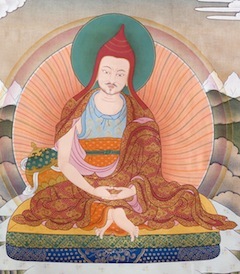Overview of the Bodhicaryāvatāra
Collections & Cycles › Thirteen Great Texts › Bodhicaryāvatāra | Tibetan Masters › Minyak Kunzang Sönam
English | Español | Français | བོད་ཡིག

Śāntideva, author of the Bodhicaryāvatāra
© Tertön Sogyal Trust. Painted by Salga.
Further information:
- Treasury of Lives Author Bio
- BDRC Author Profile (P4069)
- BDRC Work Profiles W15659 W19740
Bodhicaryāvatāra Overview
by Minyak Kunzang Sönam
Ācārya Kṛṣṇapāda explains the main body of the treatise in three parts. He says that the first three verses show the reasons for the treatise coming into being. Then the text teaches the conduct of the six pāramitās. The first three chapters and the dedication chapter teach generosity, the fourth and fifth chapters teach discipline, and the next four chapters, beginning with the sixth, teach the remaining four pāramitās. Finally, he says, the text concludes with a homage of remembering kindness.[1] Nevertheless, it should be pointed out that the subject matter of the first three chapters is mainly generating bodhicitta and generosity is only taught as an ancillary topic.
Ācārya Kalyāṇadeva describes the text by dividing it into three virtuous parts: the virtuous beginning which is the homage, the virtuous main part which continues until the dedication, and the virtuous conclusion which is the dedication.
Other past scholars claimed that the first two verses advise us not to waste the freedoms and advantages, and to make this life meaningful. Then the first chapter shows the benefits of bodhicitta; the second and third show the method of generating bodhicitta; the fourth and fifth show the way to guard the training; and of the actual nature of the training, which consists of the six pāramitās, the first two pāramitās are to be understood from the first five chapters, while the remaining four, beginning with patience, are taught in the next four chapters of patience and the rest.
Ācārya Vairocanarakṣita says that the explanation of the benefits of bodhicitta begins with the verse, “This free and well-favoured human form…” Yet Vibhūticandra and most Tibetan commentaries quite logically explain that the first two verses reveal the necessary support for bodhicitta, and that is how it will be explained here. More specifically, these two verses teach firstly the physical support, by explaining the difficulty of gaining the freedoms and advantages, and then the mental support by explaining how difficult it is to develop a virtuous state of mind.
Thereafter, the main topic of the text is explained. How? For the most part, it is in accordance with the explanations mentioned above, but to explain in a little more detail:
- In the beginning it is necessary to develop inspiration and enthusiasm for the Mahāyāna teachings by seeing the benefits of generating bodhicitta, so the first chapter reveals these benefits.
- Then, we need to confess our misdeeds, which are not conducive to developing bodhicitta, and to accumulate merit in order to create the right conducive circumstances, so these are taught in the second and third chapters.
- Having generated bodhicitta, the method of training in activity as a foundation for the attainment of great enlightenment is then taught in general and specific terms. From the perspective of the first, because conscientiousness is so important as a means of ensuring that our activity does not degenerate and that we adopt positive actions and avoid negative ones, that is taught in the four chapter.
- Then, more specifically, chapter five teaches how to train in discipline by relying on mindfulness and awareness while practising the six pāramitās.
- Then the next four pāramitās of patience and so on are taught in the four chapters that follow.
- The method of training in generosity, how to train the mind in giving away our body, possessions and sources of merit to others, is shown in the tenth chapter in particular.
Or, to put it another way, we could say that the fourth and fifth chapters teach discipline. Generosity is taught in the verses on offering to the Three Jewels and giving away ones’ body, possessions and sources of merit, and although there is not a particular chapter devoted to it, it is still to be found here extensively, and is also taught in the tenth chapter by the acts that conclude the treatise, the dedication of merit and the homage of remembering kindness.
Therefore, this treatise teaches all the stages of the path to awakening, beginning with the mind training of the path common to beings of lesser and middling capacity, which serves a preliminary to the mind training in the approach of great beings, and then the generation of bodhicitta and the training in the bodhisattva’s actions. The nature of the fruition of buddhahood is also taught briefly in the ninth chapter.
Taken from The Excellent Vase that Grants the Qualities of the Bodhisattvas (rgyal sras yon tan bum bzang) by Minyak Kunzang Sonam.
| Translated by Adam Pearcey, 2007.
Version: 1.2-20220825
-
i.e., Chapter 10, v 58. ↩